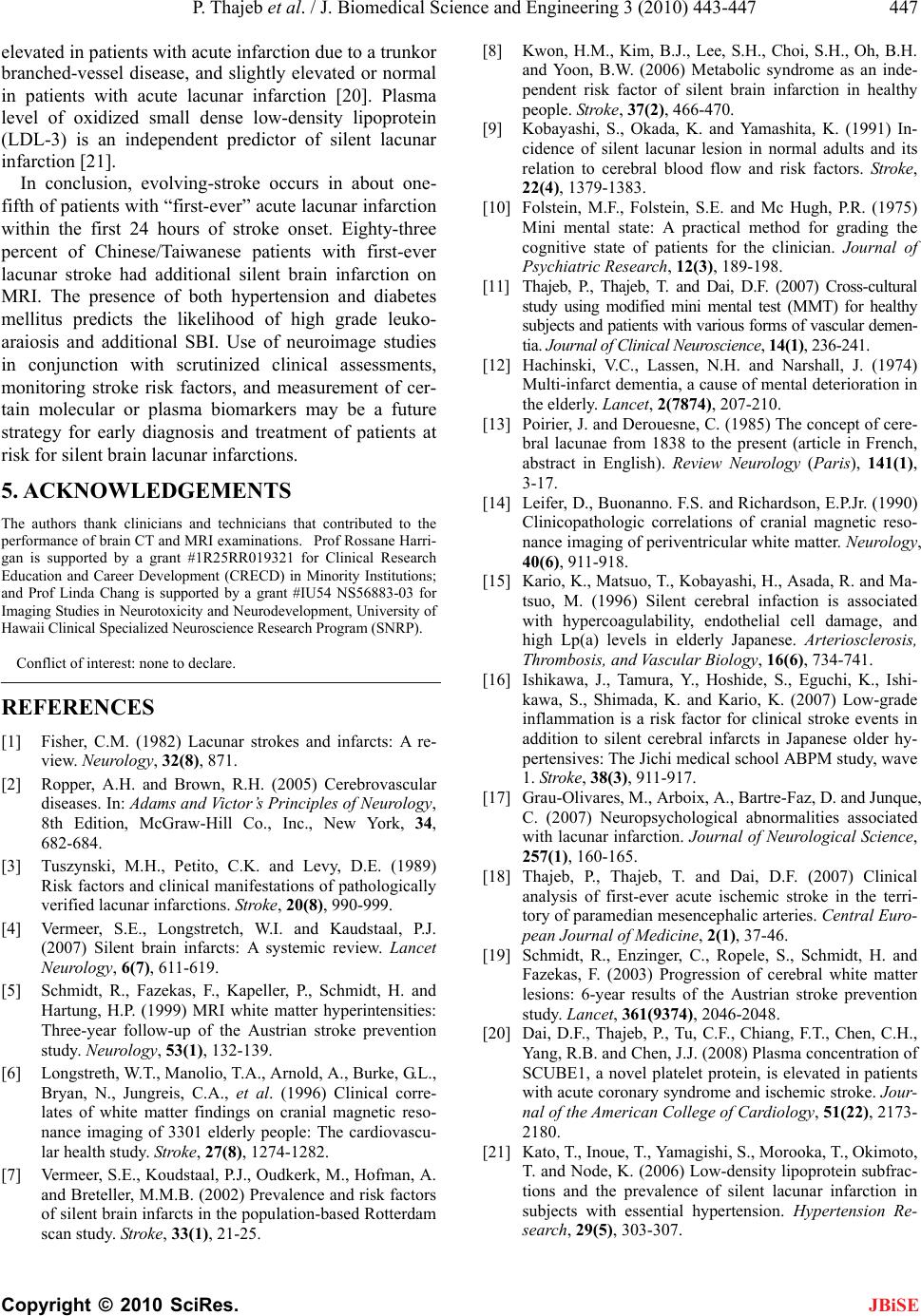
P. Thajeb et al. / J. Biomedical Science and Engineering 3 (2010) 443-447 447
Copyright © 2010 SciRes. JBiSE
elevated in patients with acute infarction due to a trunkor
branched-vessel disease, and slightly elevated or normal
in patients with acute lacunar infarction [20]. Plasma
level of oxidized small dense low-density lipoprotein
(LDL-3) is an independent predictor of silent lacunar
infarction [21].
In conclusion, evolving-stroke occurs in about one-
fifth of patients with “first-ever” acute lacunar infarction
within the first 24 hours of stroke onset. Eighty-three
percent of Chinese/Taiwanese patients with first-ever
lacunar stroke had additional silent brain infarction on
MRI. The presence of both hypertension and diabetes
mellitus predicts the likelihood of high grade leuko-
araiosis and additional SBI. Use of neuroimage studies
in conjunction with scrutinized clinical assessments,
monitoring stroke risk factors, and measurement of cer-
tain molecular or plasma biomarkers may be a future
strategy for early diagnosis and treatment of patients at
risk for silent brain lacunar infarctions.
5. ACKNOWLEDGEMENTS
The authors thank clinicians and technicians that contributed to the
performance of brain CT and MRI examinations. Prof Rossane Harri-
gan is supported by a grant #1R25RR019321 for Clinical Research
Education and Career Development (CRECD) in Minority Institutions;
and Prof Linda Chang is supported by a grant #IU54 NS56883-03 for
Imaging Studies in Neurotoxicity and Neurodevelopment, University of
Hawaii Clinical Specialized Neuroscience Research Program (SNRP).
Conflict of interest: none to declare.
REFERENCES
[1] Fisher, C.M. (1982) Lacunar strokes and infarcts: A re-
view. Neurology, 32(8), 871.
[2] Ropper, A.H. and Brown, R.H. (2005) Cerebrovascular
diseases. In: Adams and Victor’s Principles of Neurology,
8th Edition, McGraw-Hill Co., Inc., New York, 34,
682-684.
[3] Tuszynski, M.H., Petito, C.K. and Levy, D.E. (1989)
Risk factors and clinical manifestations of pathologically
verified lacunar infarctions. Stro ke, 20(8), 990-999.
[4] Vermeer, S.E., Longstretch, W.I. and Kaudstaal, P.J.
(2007) Silent brain infarcts: A systemic review. Lancet
Neurology, 6(7), 611-619.
[5] Schmidt, R., Fazekas, F., Kapeller, P., Schmidt, H. and
Hartung, H.P. (1999) MRI white matter hyperintensities:
Three-year follow-up of the Austrian stroke prevention
study. Neurology, 53(1), 132-139.
[6] Longstreth, W.T., Manolio, T.A., Arnold, A., Burke, G.L.,
Bryan, N., Jungreis, C.A., et al. (1996) Clinical corre-
lates of white matter findings on cranial magnetic reso-
nance imaging of 3301 elderly people: The cardiovascu-
lar health study. St ro ke , 27(8), 1274-1282.
[7] Vermeer, S.E., Koudstaal, P.J., Oudkerk, M., Hofman, A.
and Breteller, M.M.B. (2002) Prevalence and risk factors
of silent brain infarcts in the population-based Rotterdam
scan study. Stro ke, 33(1), 21-25.
[8] Kwon, H.M., Kim, B.J., Lee, S.H., Choi, S.H., Oh, B.H.
and Yoon, B.W. (2006) Metabolic syndrome as an inde-
pendent risk factor of silent brain infarction in healthy
people. Stroke, 37(2), 466-470.
[9] Kobayashi, S., Okada, K. and Yamashita, K. (1991) In-
cidence of silent lacunar lesion in normal adults and its
relation to cerebral blood flow and risk factors. Stro ke,
22(4), 1379-1383.
[10] Folstein, M.F., Folstein, S.E. and Mc Hugh, P.R. (1975)
Mini mental state: A practical method for grading the
cognitive state of patients for the clinician. Journal of
Psychiatric Research, 12(3), 189-198.
[11] Thajeb, P., Thajeb, T. and Dai, D.F. (2007) Cross-cultural
study using modified mini mental test (MMT) for healthy
subjects and patients with various forms of vascular demen-
tia. Journal of Clinical Neuroscience, 14(1), 236-241.
[12] Hachinski, V.C., Lassen, N.H. and Narshall, J. (1974)
Multi-infarct dementia, a cause of mental deterioration in
the elderly. Lancet, 2(7874), 207-210.
[13] Poirier, J. and Derouesne, C. (1985) The concept of cere-
bral lacunae from 1838 to the present (article in French,
abstract in English). Review Neurology (Paris), 141(1),
3-17.
[14] Leifer, D., Buonanno. F.S. and Richardson, E.P.Jr. (1990)
Clinicopathologic correlations of cranial magnetic reso-
nance imaging of periventricular white matter. Neurology,
40(6), 911-918.
[15] Kario, K., Matsuo, T., Kobayashi, H., Asada, R. and Ma-
tsuo, M. (1996) Silent cerebral infaction is associated
with hypercoagulability, endothelial cell damage, and
high Lp(a) levels in elderly Japanese. Arteriosclerosis,
Thrombosis, and Vascular Biology, 16(6), 734-741.
[16] Ishikawa, J., Tamura, Y., Hoshide, S., Eguchi, K., Ishi-
kawa, S., Shimada, K. and Kario, K. (2007) Low-grade
inflammation is a risk factor for clinical stroke events in
addition to silent cerebral infarcts in Japanese older hy-
pertensives: The Jichi medical school ABPM study, wave
1. St ro ke, 38(3), 911-917.
[17] Grau-Olivares, M., Arboix, A., Bartre-Faz, D. and Junque,
C. (2007) Neuropsychological abnormalities associated
with lacunar infarction. Journal of Neurological Science,
257(1), 160-165.
[18] Thajeb, P., Thajeb, T. and Dai, D.F. (2007) Clinical
analysis of first-ever acute ischemic stroke in the terri-
tory of paramedian mesencephalic arteries. Central Euro-
pean Journal of Medicine, 2(1), 37-46.
[19] Schmidt, R., Enzinger, C., Ropele, S., Schmidt, H. and
Fazekas, F. (2003) Progression of cerebral white matter
lesions: 6-year results of the Austrian stroke prevention
study. Lancet, 361(9374), 2046-2048.
[20] Dai, D.F., Thajeb, P., Tu, C.F., Chiang, F.T., Chen, C.H.,
Yang, R.B. and Chen, J.J. (2008) Plasma concentration of
SCUBE1, a novel platelet protein, is elevated in patients
with acute coronary syndrome and ischemic stroke. Jour-
nal of the American College of Cardiology, 51(22), 2173-
2180.
[21] Kato, T., Inoue, T., Yamagishi, S., Morooka, T., Okimoto,
T. and Node, K. (2006) Low-density lipoprotein subfrac-
tions and the prevalence of silent lacunar infarction in
subjects with essential hypertension. Hypertension Re-
search, 29(5), 303-307.